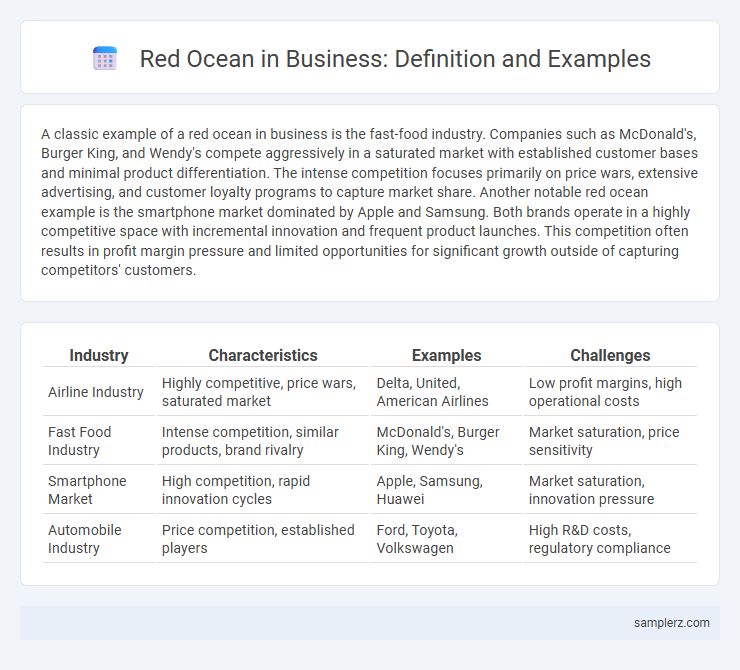A classic example of a red ocean in business is the fast-food industry. Companies such as McDonald's, Burger King, and Wendy's compete aggressively in a saturated market with established customer bases and minimal product differentiation. The intense competition focuses primarily on price wars, extensive advertising, and customer loyalty programs to capture market share. Another notable red ocean example is the smartphone market dominated by Apple and Samsung. Both brands operate in a highly competitive space with incremental innovation and frequent product launches. This competition often results in profit margin pressure and limited opportunities for significant growth outside of capturing competitors' customers.
Table of Comparison
| Industry | Characteristics | Examples | Challenges |
|---|---|---|---|
| Airline Industry | Highly competitive, price wars, saturated market | Delta, United, American Airlines | Low profit margins, high operational costs |
| Fast Food Industry | Intense competition, similar products, brand rivalry | McDonald's, Burger King, Wendy's | Market saturation, price sensitivity |
| Smartphone Market | High competition, rapid innovation cycles | Apple, Samsung, Huawei | Market saturation, innovation pressure |
| Automobile Industry | Price competition, established players | Ford, Toyota, Volkswagen | High R&D costs, regulatory compliance |
Defining Red Ocean Strategies in Modern Business
Red ocean strategies in modern business involve competing in existing markets by outperforming rivals through cost leadership or differentiation, often leading to intense competition and shrinking profit margins. A prime example is the smartphone industry, where companies like Apple and Samsung battle aggressively over market share with incremental innovations and aggressive pricing. These strategies emphasize exploiting known demand and existing market space, making competition a zero-sum game.
Characteristics of Red Ocean Markets
Red ocean markets are characterized by intense competition where businesses vie for the same customer base, leading to saturated industries with limited growth potential. Companies in red oceans often compete on price, resulting in thinner profit margins and declining differentiation. Examples include the smartphone industry and fast-food chains, where established players focus on outperforming rivals rather than creating new demand.
Classic Example: The Airline Industry Price Wars
The airline industry price wars exemplify a classic red ocean market where companies compete fiercely in a saturated market by undercutting ticket prices to capture market share. Major carriers continuously lower fares, leading to reduced profit margins and intense rivalry, limiting opportunities for innovation or differentiation. This cutthroat competition often results in commoditization of services, driving companies to focus on cost leadership rather than creating unique value propositions.
Fast Food Chains Battling for Market Share
Fast food chains such as McDonald's, Burger King, and Wendy's operate within a red ocean characterized by fierce competition for market share through price cuts, menu diversification, and aggressive advertising. These companies invest heavily in quick service, extensive locations, and promotional campaigns to attract and retain customers in a saturated market. The intense rivalry limits profit margins and drives continuous innovation to differentiate offerings amid nearly identical products.
Smartphone Business: Competing Through Saturation
The smartphone business exemplifies a red ocean market characterized by intense competition and market saturation, where leading brands like Apple, Samsung, and Huawei relentlessly vie for market share through incremental innovations and aggressive marketing campaigns. Price wars, frequent product launches, and feature saturation dominate strategies as companies aim to outpace rivals within an already crowded market. This relentless competition drives down profit margins and creates high barriers for new entrants, illustrating the challenges of navigating a red ocean environment.
The Bottled Water Industry’s Fierce Competition
The bottled water industry exemplifies a red ocean market characterized by intense competition among established brands like Aquafina, Dasani, and Evian, all vying for market share in a saturated environment. Companies aggressively compete on price, branding, and distribution channels, leading to razor-thin profit margins and limited growth opportunities. Market saturation and commoditization force firms to innovate in packaging and marketing strategies to differentiate themselves amid fierce rivalry.
Retail Supermarkets Engaged in Price Competition
Retail supermarkets exemplify a red ocean market characterized by intense price competition, where businesses aggressively lower prices to attract cost-conscious consumers. This strategy often leads to shrinking profit margins and limited differentiation among competitors, resulting in a saturated marketplace. Key players invest heavily in promotions and discounts to maintain market share, intensifying the rivalry within this commoditized industry.
Automobile Market: Fighting for Consumer Attention
The automobile market exemplifies a red ocean with fierce competition among established brands such as Toyota, Ford, and Volkswagen, all vying for consumer attention through similar product offerings and price wars. Companies invest heavily in marketing campaigns, innovation of incremental features, and extensive dealer networks to capture market share in this saturated industry. This intense rivalry limits profit margins and necessitates constant differentiation to maintain visibility in the crowded automotive landscape.
Traditional Banking Sector’s Red Ocean Environment
The traditional banking sector exemplifies a red ocean environment characterized by intense competition among established financial institutions offering similar products like savings accounts, loans, and credit cards. Market saturation and minimal product differentiation lead to fierce price wars, reduced profit margins, and high customer acquisition costs. Banks focus heavily on incremental innovations and operational efficiency to maintain market share within this highly contested landscape.
Lessons Learned from Red Ocean Business Battles
Companies competing in the smartphone industry illustrate red ocean strategies, where intense rivalry drives price wars and thin profit margins. Lessons from these battles emphasize the importance of differentiation through innovation, as seen in Apple's focus on ecosystem integration and user experience. Businesses must avoid solely competing on cost and instead create unique value propositions to sustain profitability in saturated markets.

example of red ocean in business Infographic
 samplerz.com
samplerz.com